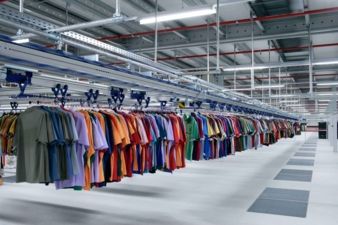28/08/2019 – 200 Years of Dematic — auf Deutsch lesen
Dematic Takes a Look Back at History: Developments in Overhead Conveyor Technology
At the beginning of the 20th century, the production halls offered a completely different picture than today: many employees moved the heavy goods at times from workstation to workstation.
Gradually, relief systems matured up to today's high-tech standards. Dematic and its predecessor companies, which have been introducing new solutions for in-house material flow to the market for 200 years, have played a key role in this development.
The Stöhr Elevatorenfabrik, founded in March 1900, developed the first conveyor systems and thus relieved employees of heavy physical work. With the circular conveyor, Dematic's predecessor revolutionised the in-ternal material flow during this time. Its main components were a conveyor chain, load carrier, a conveyor track and an electric drive.
As one of the first systems ever, the continuous conveyor could not only be mounted on walls but also from the ceiling. This design principle allowed a completely new and more effective use of space in the factories. It was also able to elegantly overcome height differences and connect separate areas. Goods of any kind weighing up to 100 kilograms were transported. No wonder the system has been used in so many different industry branches. For example, renowned companies such as Gussstahlfabrik Krupp and Waschmittelfabrik Henkel were part of the customer base. But the continuous conveyor also reliably conveyed goods in the brewing in-dustry, in newspaper printing houses as well as in the food and beverage industry. A special sight at that time, it was able to transport banana plants, which moved faster and thus fresher to the final consumers by the overhead conveyor.
Neckermann’s first fully automatic warehouse was founded in 1962
After the entire Stöhr works were destroyed in the Second World War and then rebuilt, the company developed the first fully automatic warehouse for Neckermann in 1962. Part of the solution was also two circular conveyors, which carried pieces of clothing hanging from the ceiling. They included 280 load carriers each with 25 collection trays.
This was a real breakthrough, because from now on, up to 150,000 customer orders could be put together from the 27,000 articles each day due to the new solution. Other elements of the automation solution were two chain conveyors with target control running along the storage racks.
The orders that the customers had placed by punch card were first read into a large computer system. It then listed from where the goods were pulled and where they had to be deposited. Employees at the conveyor belts then picked the orders. The final packaging was automatic.
Electric Monorail System DSB – first step towards digitalisation in 1975
In 1975, the first digital step was taken by the predecessor company Mannesmann Demag, which introduced a powerful automated overhead conveyor to the market with the DSB electric monorail system. Depending on the customer requirement, it conveyed, distributed, buffered, stored or gathered goods together. Loads of up to 2,400 kilograms could be conveyed. Control was provided by programmable logic controllers (PLCs), which in the 1970s for the first time made it possible to operate systems and machines digitally. For example, the electric overhead conveyor was installed at the University Hospital Düsseldorf.
In 2005, the Dematic GmbH and Co. KG was founded
With different solu-tions, the company continues to shape the development of overhead con-veyor technology. A proven solution is the Garments on Hangers (GOH), an automatic hanging warehouse, which is still used by many companies today. The system makes it possible to automatically store, transport and pick hanging goods. The company then launched the next generation of overhead conveyor technology on the market with its pouch sorting system. This system is ideal for use in fulfilment and returns processing, especially for e-commerce companies. Because the automated hanging system is based on roller adapters, both hanging and flat goods as well as flat packaged items and boxes can be sorted and stored temporarily. In addition to automatic pouch loading, automatic pouch unloading is now also possible. The pouches can now also be opened at any point in the system via an innovative and unique opening and closing mechanism. Compared to a manual solution, the pouch unloading per hour can be increased six fold.
Rainer Buchmann, CEO Dematic Central Europe:
“Developing innovative solutions in the field of overhead conveyor technology has always been part of our DNA. We will also continue to drive the market decisively in the future.”




